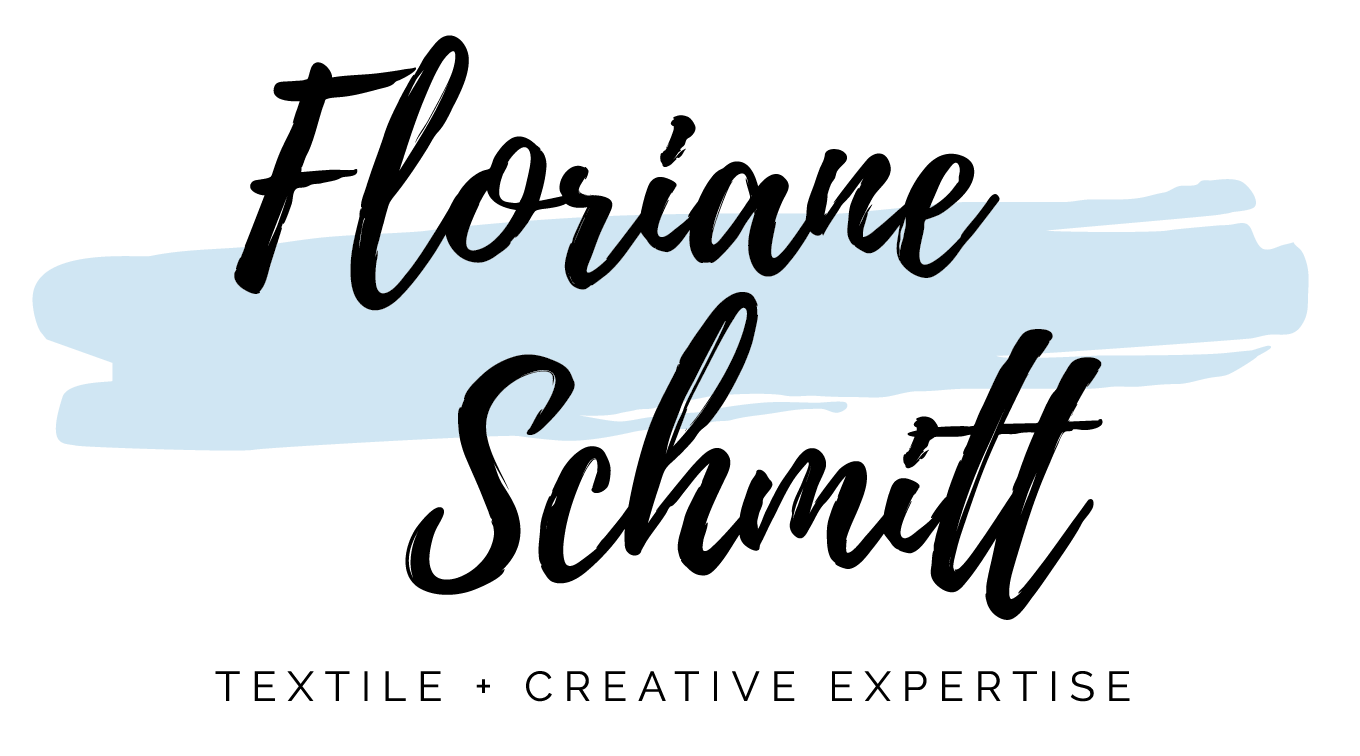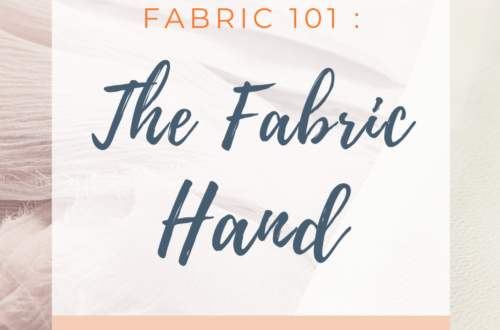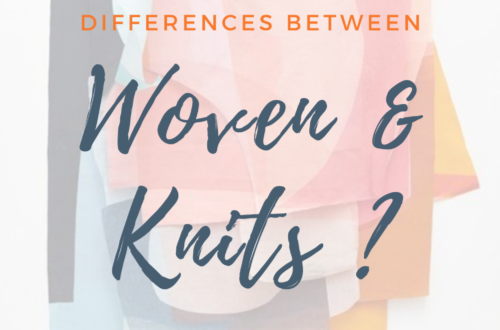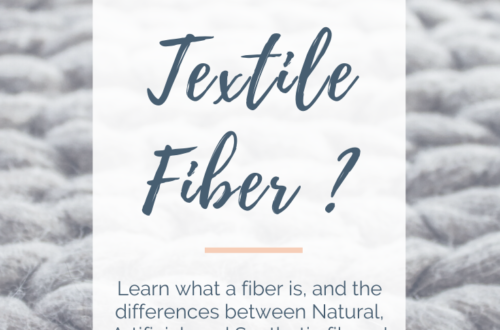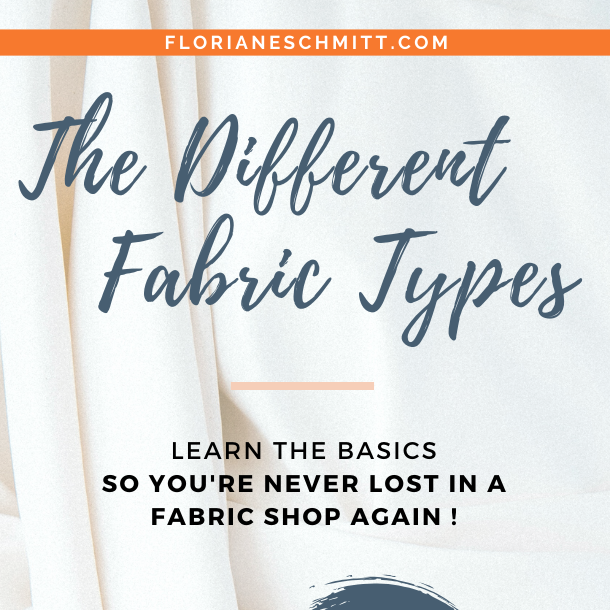
The Different Types of Fabric
Hello Creative Souls ! Today I’m explaining the different types of fabrics. With so many existing textiles, it’s normal to get confused on how to choose fabrics for your creations. So let’s start with the basics ! The categories we are talking about today are quite broad, and they will give us a global view of what’s existing.
Why do you need to know about all the types of textiles ?
Well, first, to stop getting lost whenever you enter a fabric shop ! Those categories are how they class the fabrics on the shelves. It also helps when you visit fabric fair, they organize the areas by type of textiles as well !
Second, each category has similar properties and hand feel. So when you look for a specific look, you’ll know exactly where to look first. You’ll save so much time !
Let’s dive in those types of fabric !
I’ll be adding specific posts for each type of fabric and categories, I’ll update the links here as I publish them !
COTTONS
What :
Any woven fabric with mainly cotton inside. Can be a cotton-polyester blend, or cotton-linen blend, or any type of blend ! Linen are also included in this category.
Cottons are not expensive, easy to live in, and usually soft.
Use :
The range of uses is super large ! In fashion, you can make any type of pieces, from a t-shirt to a thick jacket. Let’s review that :
- Elegant Fashion : formal shirts & dresses
- Casual Fashion : relaxed shirts, jeans, trench, chinos
- Interior : Beddings, pillow & cushions cases, table cloth … Cotton & Linen are the best and most used fabric for the home !
Cottons are the most common type of fabrics.
Example of fabrics :
- Canvas
- Crepon
- Gauze
- Batiste
- Chambray
- Cotton voile
- Organdi
- Chintz
- Oxford cloth
- Popelin
- Piqué weave
- Percale
- Seersucker
- Denim
- Chino
- Corduroy
- Terry
- Cotton gabardine
- Ottoman
- Linen
SILKIES
What :
Any woven fabric with the thin and fluid aspect of silk. For a cheaper version, viscose (also called Rayon) is usually the substitute for silk, and sometimes it can be polyester.
Use :
- Fashion : Elegant or everyday garment like dresses & blouses, scarfs, ties, linings
- Interior : Pillow cases (in satin or velvet), bedding in general, rugs, curtains. They create a special look, quite shiny and luxurious.
Example of fabrics :
- Chiffon
- Mousseline
- Satin
- Duchesse Satin
- Organza
- Twill [Used for Hermes’ Scarfs and Twilly !]
- Taffeta
- Pongé
- Faille
- Crêpe de Chine
- Crêpe georgette
- Gazar [Cristobal Balenciaga’s favorite fabric !]
- Shantung
- Doupion
- Velvet
WOOLS
What :
Any fabric with the aspect of wool, no matter the animal it’s from or it’s mimicking. Wools usually refers to woven fabrics, more than knitted. [See the Knits sections under to learn about fabrics used for sweaters]
Animals who produce wool are : sheeps (classic and Merino), goats (Cashmere & Mohair), rabbits (Angora), as well as camel, alpaga, vicuna, etc.
Cheaper version are usually made by adding polyester or acrylic to wool, creating a blend, or using plain acrylic.
Wools are super insular, repels water and don’t wrinkle.
Wools are classed by their weight :
- Coatings (coat weight) are the heaviest and are the fabrics for coats
- Suitings (suit weights) are the lightest and are the fabrics for trousers and suits
- Sometimes we use the intermediary term “jacket weight” to qualify medium weighted fabrics, that we use for jackets & skirts.
Use :
- Elegant Fashion : Coats, suits
- Interior : Carpet, upholstery, artworks, cushions, curtains, throws
Example of fabrics :
- Melton
- Reefer
- Loden
- Wool velvet
- Double fabric
- Flanelle
- Tweed
- Wool Fleece
- Bouclette
- Gabardine
- Whipcord
- Twill
- Wool crêpe
- Wool sateen
- Grain de poudre
- Prunelle
- Etamine
- Tartan
- Glen plaid
- Houndstooth
- Pinstripe
- Chalk stripe
- Herringbone
KNITS
What :
Knits are all the cloths that were made using the knitting technique, as opposed to wovens. When hand-knitting, one thread is used for the entire piece. It create cloths that are really supple, comfortable, and soft.
Usual compositions includes wool (sheep wool, cashmere, merinos, angora …), acetate or polyester.
We can distinguish :
- Weft knits : used for sweaters, T-shirts, hosiery, really supple, comfortable & stretch
- Warp knits : used for lingerie & sportswear, offer better hold
Use :
- Casual Fashion : Sweater, cardigans, Polos, T-shirt
- Men & Women Underwear
- Women Bathing suits
- Hosiery : Socks, stockings, tights
- Interior : Plaids, cushions, chairs, …
Example of fabrics :
- Weft knit :
- Piqué knit [for Polos]
- Terrycloth
- Milano
- Fleece
- Warp knit :
- Powernet
- Locknit
- Satin knit
- Microfibre
- Infinite number of structures, including :
- Jersey
- Purl knit
- Rib (1×1 or 2×2)
- Interlock [jersey on both sides]
- Cardigan Rib
- Cable knit
- Openwork knit
- Jacquard [to create colored pattern] :
- Jacquard with floating yarns
- Rib Jacquard
- Intarsia Jacquard
LACE
What :
Laces are quite common and easy to recognize with their patterns, often flowers. But a variety of techniques to make them exists ; handmade or by machine, that are less well-known.
Lace was of course handmade at first, mostly in France and Europe. A lot of different styles exists, with its own name, techniques, and region of origin. They use bobbins or needles to be made.
Machine made lace appeared in the 19th century and we can separate lace in 3 main categories :
- Woven lace : made with Leavers Looms. Finest, most expensive lace, with rich textures and patterns
- Knit lace : made with Textronic machines, Jacquard Tronic machines, or Raschel looms. Cheaper and faster than Leavers, procducing fabrics with less relief
- Guipure : a pattern is embroidered on a water-soluble ground, that will disappear, leaving the embroidery alone. A lot of open ground, thick texture.
Common compositions for these types of fabrics are cotton, cotton-polyester blend, polyester or silk.
Use :
- Elegant Fashion : dresses, blouses, wedding dresses
- Interior : tablecloth, curtains
Example of fabrics :
- Handmade lace :
- Alençon Needle Lace
- Filet Needle Lace
- Point de gaze
- Antwerp Bobbin Lace
- Chantilly Bobbin Lace
- Valenciennes Bobbin Lace
- There are a lot of different ones, depending on the regions !
- Machine-made lace
- Leavers Lace
- Raschel lace
- Guipure lace, or Chemical lace
- Schiffli lace
TECHNICALS
What :
Any synthetic fabric, usually used for sportswear or athleisure wear, where specific properties are needed, like breathing, waterproof, anti-UV, etc. Most common compositions are Polyesters, Polyamids, Polyurethane, and complex blends.
Each fabric is created to answer a specific need.
Use :
- Sport clothes, athleisure wear
- Interior : Any product that is made with textile can be made with a technical fabric, either because of cheaper price or special properties. Properties needed in interior are often fireproof, water repellent, low flame spread rating, resilience and easy care
Example of fabrics :
- Piqué knit
- Mesh
- Spacer
- Fleece
- Goretex ®
- Cordura ®
- Lycra ® [a brand name of Elastane]
- Nylon ® [a brand name of Polyamid]
- Ripstop
- Foamback
- Soft shells
- High-density fabrics
- Coated fabrics
- Laminated fabrics
LININGS
What :
Fabrics used inside clothes to hide sewings. Usually light with a smooth surface.
Common compositions are polyester and acetate, and sometimes cotton or silk.
Use :
- Fashion : Coats, jackets, suits
LEATHER & FURS
(They are not textiles, they are Leather or Fur, but I thought I’d add it anyway because they can be in fabric shops as well 🙊)
What :
Any material that has the aspect of leather or fur. Fake leather is often made with a Polyurethane (PU) coating, sometimes Polyamid (PA) or (less and less because it’s more polluting) Vinyl. Fake fur is often made with Acrylic.
To make fake leather, we add a coating (= a layer of plastic) on top of a base fabric. We can give it any aspect we want with molding machines (like a leather pattern !).
Animals who produce leather : cow, goat, sheep, lamp, alligators, ostrich, snakes, fish, …
Animals who produce fur : cows, sheeps, rabbits, foxes, mink, …
Use :
- Fashion : mostly jackets
- Shoes
- Leathergoods : bags, belts, wallets, purses …
- Interior : Couchs, upholstery, various accessories for the office, Decorative skins
Examples of leathers & furs :
- Grained leather
- Smooth leather
- Patent leather
- Safiano leather
- Suede
- Nubuck
- Split leather
- Shearling
- Fur
And here it is for the main types of fabric !
You might have seen within the fabric names that some names come back in several types of textiles ! For instance, you can find woolen crêpe, or silk crêpe. The same happens for twill, and many others. It’s not a mistake ! Fabrics can be qualified in a lot of different ways. With this article, I qualified the general categories of fabrics, aka those you find in a shop.
But twill is referring to the weave of the fabric, meaning the way it is structured. That’s another way to classify fabrics ; by structure (wovens, knits or non-wovens). There is another important way to classify the types of fabrics ; and that is by fiber composition (silk, polyester, cotton, etc).
So there are actually 3 ways to think about the types of fabric !
Confused by all of these crazy technical terms ?
Don’t worry, I have a cheat sheet for you !
It includes the diagrams for these 3 ways to categorize fabric types :
- by general Categories
- by Structure
- by Fiber Composition
Download it to get an easy to understand infographic, and be sure to understand everything about fabric types from now on !

Pin this for later !
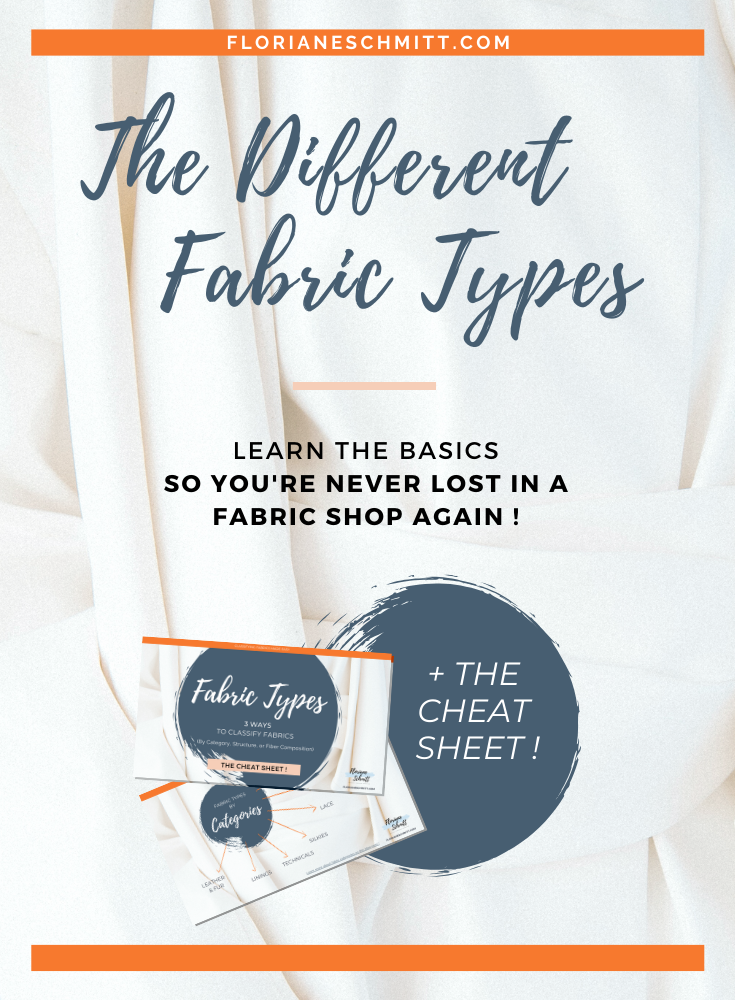

Floriane Schmitt is a textile designer, sharing her knowledge about textiles + creativity. She graduated with honors at a Parisian fashion school in Fashion Design & Fashion Business, and started her career with Flo Home Delight, her creative textile studio. Discover her collections on www.flohomedelight.com. She is also teaching creative souls how to become better designers, using textile as a main medium.


